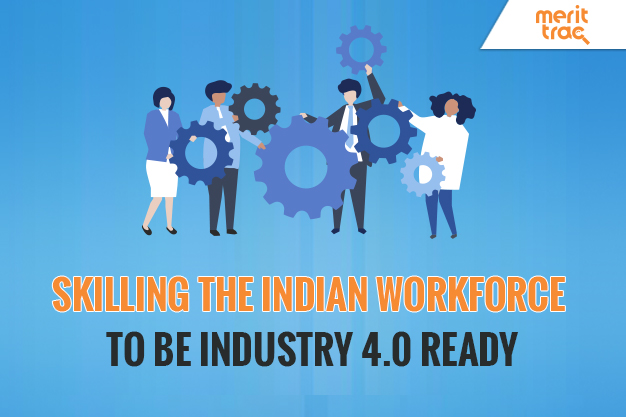
Skilling the Indian Workforce to be Industry 4.0 Ready
Date: 01/09/2019 | Posted by: MeritTrac | Category: Corporate , Skills Development
As Industry 4.0 model gains ground across manufacturing and services industries, the future of work is set to be greatly transformed. Characterised by the convergence of digital technologies cutting across the physical and digital worlds, Industry 4.0 will make many jobs and ways of working redundant while many others will be created afresh. But what separates Industry 4.0 from the previous revolutions is the unprecedented speed and spread of technological change. While in the past, India’s IT sector has progressed, thanks to a rich talent pool and low cost of labour, the skill sets that were in demand till a few years ago are now becoming obsolete. In what is being dubbed as India’s largest HR challenge, the country is looking to right-skill two million employees within the next three years.[i] At present, only about 4.7% of the total workforce in India has undergone formal skill training. [ii] What’s worse - employability of skilled graduates is also dismally low. Of the more than three million graduates and post-graduates entering the Indian workforce each year, according to NASSCOM, only 25% of technical graduates and 10–15% of other graduates are considered employable by the IT and ITES segments in the country.[iii] The potential cost of the growing skills crisis? India could lose up to 2.3% points from its annual growth rate and this could be as high as USD 1.97 trillion over 2018–28. Is there a way India could turn its skilling divide into an opportunity for growth?
IT Workforce in India
Over the years, the IT sector has become a significant contributor to the growth of the Indian economy. In 2019 the sector had generated over 180 billion dollars as annual revenue. It is estimated that there are more than 3 million professionals directly employed in the Indian IT sector. The number is set to rise as companies are shifting focus to high end IT services like consulting and software R & D.
Advancements in the IT sector are also facilitating employment in BFSI, retail, health & pharma, manufacturing, telecommunications, energy, travel, and communication, which adds to an increased number of indirectly employed individuals, which increases the strength of the IT workforce. The Indian IT sector is also investing in employee skill assessment tools for specialized domains. The assessment reports are used to create personalized training programs that facilitate upskilling and reskilling. This initiative will enable the IT sector in India to evolve and generate value for both the employees and the customers.
Industry 4.0 and the Indian Education System
Industry 4.0 that encompasses Artificial intelligence, Robotics, Big data, and the Internet of things are set to change the nature of jobs. The Indian education system is transforming to provide better learning opportunities to prepare the younger generation for automation-dominated jobs of the future. Students are introduced to the nuances of Artificial Intelligence, machine learning, and digital, experiential learning by introducing new teaching methods that simplify knowledge transfer. The application of Information and Communication Technology in the educational sector also helps to create platforms that not only personalize teaching based on various learning levels but also improve student assistance on an individual basis. The fact that these learning platforms can be accessed from smart devices from any part of the world makes online learning all the more appealing to the tech-savvy Millennials. If the Indian education sector can successfully channel these new-age technologies, then the country will soon be able to equip its students to be future-ready.
Grabbing the great Indian skilling opportunity
Even as the wide skills gap is evident, there’s another side to the story –India has the potential to shine brightly, amid a largely volatile global economy. By 2027, India will have the world’s largest workforce, with 1 billion people aged between 15 and 64 years[iv], making the country a sought-after potential supplier of skilled manpower if it could get its skilling strategy right. Doing that requires rejigging the country’s education and training system that has long been plagued with inadequate infrastructure, resource availability, outdated curriculum and misalignment with industry needs. With Industry 4.0 and Business 4.0 taking over, nearly every new job requires a combination of complex reasoning, creativity, socio-emotional intelligence and sensory perception skills - something that traditional education isn’t wired to develop.
India needs to transition to Education 4.0 or University 2.0 as it is called to create an education system that drives the Big Indian dream. Here’s how:
- Forge partnerships between industry and high-level academia: Revising the traditional curriculum to suit current and emerging industry needs is one of the key aspects of such a partnership. When industry and academia merge forces, it can also help evolve the traditional ‘learn and do’ approach into a ‘learning by doing’ manner by formalizing internship/apprenticeship programs, hands-on workshops, mentoring or even industry relevant online courses that employ gamification or simulation techniques to offer immersive learning experiences to graduating students. Philips’ AI Lab at the Manipal Academy of Higher Education (MAHE), is one such example where the company is working with MAHE’s graduating students to help shape some of their curriculum with respect to data science, analytics and Artificial Intelligence (AI).[v]
- Launch school-facing programs to catch them young: Creating long-lasting impact requires starting at the grass roots level and this is what some companies are now doing. Philips, IBM, EXL technologies and few others are launching school programs aimed at students from the seventh to tenth class to supplement classroom teaching, specifically in STEM subjects.[vi] The programs introduce students to technologies such as AI, ML, and data science at an early age, helping them develop an understanding of what the future jobs will look like.
- Upskill/reskill existing workforce: According to NASSCOM, about 40% of India's total workforce must be reskilled over the next five years in emerging technologies such as AI, IoT, machine learning and blockchain.[vii] 2019 will see a 60% increase in demand for ML and AI specialists, and around 350,000 cloud computing roles are expected to be opened this year, says NASSCOM. Thankfully, India’s IT majors are taking note as Cognizant, Infosys and Wipro look to invest significantly on the training infrastructure and roll out “in-house” digital learning and reskilling platforms.[viii] Indian IT companies have also joined a global drive for tech reskilling of more than one million professionals on the World Economic Forum’s SkillSET portal by January 2021 – a first-ever industry initiative.[ix] The good part is the Indian government is also coming forward to join hands with the industry and is now expanding its flagship “Skill India” mission to include AI, IoT and other new-age digital technologies.[x]
Industry 4.0 Companies in India
Industry 4.0 companies have foraged their way to India and the main sectors serviced by these companies are listed below:
- Hybrid cloud computing
- Big Data
- Blockchain
- Intelligent automation
Fast forward: Bridging the skills divide through collaboration
The real premise of Industry 4.0 lies in its ability to act as an economic game changer. As India embarks on its skills development journey to match pace with the needs of Industry 4.0, there are several opportunities for organisations to collaborate with each other in defining the next-gen curriculum, cross-leveraging digital skills and knowledge, cross-pollinating best practices, driving labour mobility across industries, etc. Capitalizing on such multilateral collaborations would help create an ecosystem of skills – a marketplace that organisations can access to plug gaps in an agile, connected and cost-effective manner. You can identify high performers in your organisation and help them to upskill or reskill for new and emerging jobs by employing workforce development assessment solutions. MeritTrac’s workforce development solutions provide you with a comprehensive understanding of the employee’s technical skills, cognitive abilities, and behavioural traits which are crucial for creating impactful training programs.
References
Handpicked Articles for Futher Reading
Relevant Case Studies/Whitepapers













 Sales Hotline: USA: +1 646 916 0939 / Others: +91 80619 14700
Sales Hotline: USA: +1 646 916 0939 / Others: +91 80619 14700


